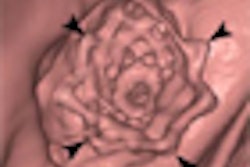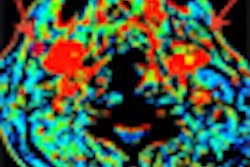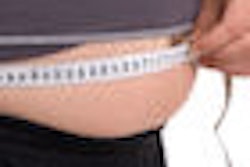A 10-year review of more than 1,000 patients at a North Carolina hospital found that preoperative CT scans may reduce unnecessary surgeries in women of reproductive age with suspected acute appendicitis, according to an article published in the February issue of Radiology.
Over 10 years, an "increase in preoperative CT use was associated with a decrease in the overall negative appendectomy rate," wrote lead author Dr. Courtney Coursey and colleagues (Radiology, 2010, Vol. 254:2, pp. 460-468). Coursey, a radiologist at Emory University in Atlanta, co-authored this study while a radiology fellow at Duke University Medical Center in Durham, NC.
Between 1998 and 2007, the researchers found that the overall negative appendectomy rate at Duke dropped by nearly half, from 16.7% to 8.7%. But the greatest reduction in appendectomies was among women ages 45 years and younger, among whom the rate plummeted from 42.9% to 7.1% during the study period. Meanwhile, among men, there was no statistically significant change in the rate, nor was there any change among older women.
The retrospective study didn't prove a direct association between CT imaging and a lower number of negative appendectomies in women, and the association between the two was unclear for male patients. However, it's known that symptoms associated with several gynecological processes can mimic those of acute appendicitis, potentially rendering CT's clearer diagnostic abilities helpful for excluding appendicitis in younger women. For example, symptomatic ovarian cysts can cause lower abdominal pain similar to that of appendicitis, the authors noted.
An unclear need
The need for appendectomy isn't always clear from the clinical presentation. In fact, before CT became common for diagnosis, surgery on inconclusive cases led to negative appendectomy rates of 25% and higher -- and up to 40% in women. Previous studies examining the role of CT in reducing negative appendectomies have shown conflicting results.
Coursey, along with Duke University Medical Center colleagues including Dr. Rendon Nelson and Dr. Mayur Patel, examined CT, pathology, and surgery reports from a surgical database of 925 patients (56.9% men, 43.1% women; mean age, 38 years [range, 18-95]) who underwent urgent appendectomy over the 10-year study period. They used logistic regression to calculate changes in the proportion of patients undergoing CT, as well as the change in numbers of appendectomy procedures and negative surgeries, and analyses based on patient age.
Preoperative CT use grew steadily over the study period. In 1998, 18.5% of patients underwent preoperative CT before acute appendectomy, compared with 93.2% of patients in 2007. Following the same trend, the negative appendectomy rate for women ages 45 and younger decreased from 42.9% in 1998 to 7.1% in 2007.
"However, the timing of the decline in negative appendectomy rates for women 45 years and younger could not be proved to be associated with the increase in CT use," Coursey and colleagues wrote. Moreover, "there was no significant trend toward a lower negative appendectomy rate for men regardless of age or for women older than 45 years of age with increased use of preoperative CT."
Duke University Medical Center's shift from single-detector CT to MDCT, and the use of decreasing section thickness, also correlated to a reduction in false-positive diagnoses, the group noted. Notably, the timelines documenting reductions in negative appendectomies did not correspond in a precise way with either the use of preoperative CT or technological improvements in the modality.
The authors concluded that increasing use of CT and advances in CT technology correlated with significant decreases in the negative appendectomy rate for women ages 45 and younger.
Gynecologic processes
Higher negative appendectomy rates in younger women have historically been attributed to gynecologic processes that can confound the diagnosis of acute appendicitis, the group wrote.
"In our study, right lower quadrant pain was ultimately attributed to gynecologic disease in 38.7% (24 of 62) of patients who underwent a negative appendectomy and for whom a definitive alternative diagnosis was established," the group reported. "Seven of these 24 patients underwent preoperative CT."
The lack of a decline in the negative appendectomy rates for men and women older than 45 years was a little "surprising," the authors added, suggesting that the lack of improvement may be related to the already-low rates of negative appendectomy in those groups, leaving the study underpowered to find a significant difference in men, for example. In every year at Duke during the study period, the number of negative appendectomies among men of all ages was in the single digits.
"We suspect that CT findings (e.g., epiploic appendagitis) that averted appendectomy were found in patients in these categories. Selective preoperative CT use in these patients is therefore likely beneficial," they wrote.
In a statement accompanying the release of the study, Coursey emphasized that even CT diagnosis isn't infallible.
"Although it's a terrific test ... our interpretation of CT images are not 100% perfect," Coursey said. "Therefore, it may be difficult to improve significantly upon diagnosis in groups with an already low negative appendectomy rate."
By Eric Barnes
AuntMinnie.com staff writer
January 28, 2010
Related Reading
Noncontrast CT accurately diagnoses acute appendicitis in adults, January 25, 2010
CT scans sent to iPhone can make appendicitis diagnoses, December 2, 2009
Limit CT exams for appendicitis in kids, November 24, 2009
CT coronal reconstructions aid pediatric appendicitis diagnosis, January 12, 2009
Feel-good CT-positive appendicitis cases rarely elude surgery, January 12, 2009
Copyright © 2010 AuntMinnie.com



















